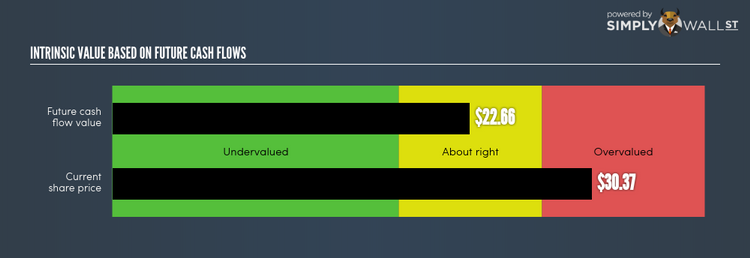An Intrinsic Value Calculation For Fifth Third Bancorp (FITB) Shows Investors Are Overpaying

Pricing FITB, a financial stock, can be difficult since these banks have cash flows that are affected by regulations that are not imposed upon other sectors. The tiered capital structure is common for banks to abide by, in order to ensure they maintain a sufficient level of cash for their customers. Focusing on elements such as book values, as well as the return and cost of equity, can be beneficial for determining FITB’s value. Today I will take you through how to value FITB in a fairly useful and uncomplicated approach. Check out our latest analysis for Fifth Third Bancorp
What Model Should You Use?
Let’s keep in mind two things – regulation and type of assets. United States’s financial regulatory environment is relatively strict. Moreover, banks tend to not possess significant portions of tangible assets on their books. While traditional DCF models emphasize on inputs such as capital expenditure and depreciation, which is less useful for a financial stock, the Excess Return model focuses on book values and stable earnings.
How Does It Work?
The central assumption for this model is that equity value is how much the firm can earn, over and above its cost of equity, given the level of equity it has in the company at the moment. The returns in excess of cost of equity is called excess returns:
Excess Return Per Share = (Stable Return On Equity – Cost Of Equity) (Book Value Of Equity Per Share)
= (9.8% – 9.87%) * $21.3 = $-0.02
Excess Return Per Share is used to calculate the terminal value of FITB, which is how much the business is expected to continue to generate over the upcoming years, in perpetuity. This is a common component of discounted cash flow models:
Terminal Value Per Share = Excess Return Per Share / (Cost of Equity – Expected Growth Rate)
= $-0.02 / (9.87% – 2.47%) = $-0.21
Putting this all together, we get the value of FITB’s share:
Value Per Share = Book Value of Equity Per Share + Terminal Value Per Share
= $21.3 + $-0.21 = $22.66
Given FITB’s current share price of $30.37, FITB is currently priced higher than its intrinsic value. Therefore, there’s no benefit to buying {[ticker_symbol]} today. Pricing is one part of the analysis of your potential investment in FITB. Analyzing fundamental factors are equally important when it comes to determining if FITB has a place in your holdings.
Next Steps:
For banks, there are three key aspects you should look at:
1. Financial health: Does it have a healthy balance sheet? Take a look at our free bank analysis with six simple checks on things like bad loans and customer deposits.
2. Future earnings: What does the market think of FITB going forward? Our analyst growth expectation chart helps visualize FITB’s growth potential over the upcoming years.
3. Dividends: Most people buy financial stocks for their healthy and stable dividends. Check out whether FITB is a dividend Rockstar with our historical and future dividend analysis.
For more details and sources, take a look at our full calculation on FITB here.
To help readers see pass the short term volatility of the financial market, we aim to bring you a long-term focused research analysis purely driven by fundamental data. Note that our analysis does not factor in the latest price sensitive company announcements.
The author is an independent contributor and at the time of publication had no position in the stocks mentioned.

